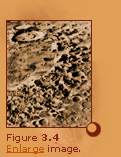|
|

Crater Degradation
Similar to craters on other celestial bodies, Martian craters can also
be degraded by slumping of crater rims (i.e., landslides), subsequent
impacts, lava flows, and ejecta from nearby impacts. In addition, Martian
craters may be weathered by water and the atmosphere.
 |
 |
Figure 3.4 is an image of the Argyre Basin, which is an ancient
impact crater about 1,000 km in diameter. Notice that the
original crater rim has been obliterated by numerous subsequent
smaller impact events. This view was taken from an orbiter. Crater
density on Mars is significantly lower than that of the Moon and
Mercury. This is probably because: (a) the number of asteroids and
meteorites decreases the further a planet is from the Sun, and (b)
subsequent geological processes on Mars, such as hydro-processes,
aeolian processes and volcanism, have significantly destroyed the
earlier impact history of the planet.
|
More
pictures of Martian craters obtained by the Global Surveyor in 1997
and 1998 are available on the JPL/NASA site.
< back 1 2
3
|



